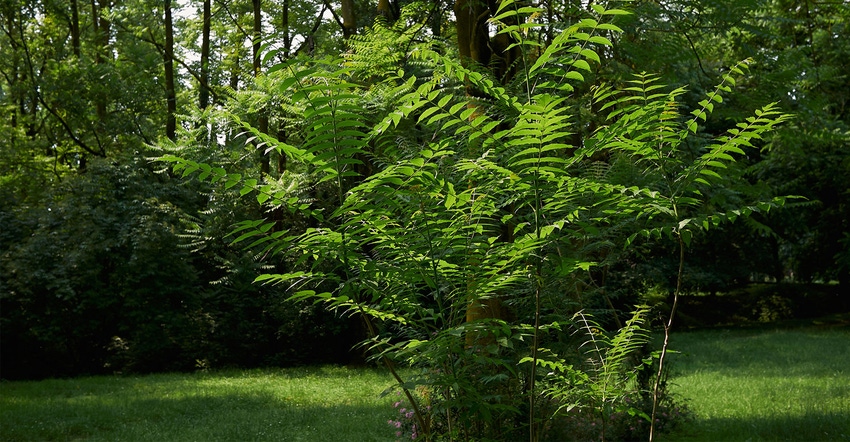
An ornamental plant considered a noxious weed in Eddy County, New Mexico, threatens to replace native plants. The invasive weed creates a dense thicket nearly impossible to destroy.
And while the weed may be known as the tree of heaven, Eddy County Agricultural Extension Agent Woods Houghton said in a telephone interview, that’s not quite how they refer to it. “Once it gets established it becomes very difficult to control or eradicate,” he said.
The U.S. Department of Agriculture’s Invasive Species Information Center warns the tree of heaven (Ailanthus altissima), or China-sumac, crowds out native species and damages pavement and building foundations in urban areas.
“The tree grows very fast, up to 15 feet its first year and can grow to 60 feet and upwards, a very persistent plant. The plant is allopathic, which means it produces a chemical that prevents other plants from growing near it and in this way dominates native plant varieties,” Houghton said.
When asked if the tree was a risk for Eddy County’s pecan orchards, he didn’t hesitate to say, “I wouldn’t want it growing anywhere near my orchard.”
NON-NATIVE
The non-native plant was introduced into the United States hundreds of years ago and is, according to the Ecological Landscape Alliance, a fast-growing, deciduous, exotic invasive tree that germinates and grows in a wide variety of soil and site conditions.
“It sprouts up just about anywhere, including alleys, sidewalks, parking lots, and arroyos. This plant is becoming a serious threat to landscape and agriculture in Eddy County,” Houghton said.
The Carlsbad Irrigation District is battling the invasive trees which like to take root in drainage ditches and along irrigation canals.
“This would become a major problem if left unchecked. But so far, they are doing a good job controlling the spread of the trees, but it is a persistent project,” Houghton added.
THE REAL THREAT
As a young plant, this tree is known for its rapid growth as well as for being a prolific seeder that establishes dense stands that push out natives. With its herbicidal effects, the tree of heaven can kill surrounding native plants and completely take over, according to the Texas Invasive Species Institute’s website.
It also is known for its unpleasant fragrance emitted from glands located on its leaves, a scent described to smell like burnt peanuts or cat urine, which discourages wildlife from feeding on it.
“The tree is a bigger problem in urban areas right now because it primarily is used as an ornamental. So, the real threat in Eddy County is because homeowners don’t realize how invasive the plant is and often mistake young tree of heaven plants as young pecan trees. They look very similar,” Houghton said.
By the time homeowners realize the plant is not a pecan or black walnut, it has already established a healthy root system and begins to produce abundant seed which can be carried by the wind.
But Houghton said so far, homeowners have been very responsive to the warnings about the tree.
ELIMINATION
Elimination of this tree/weed requires diligence, due to its abundant seed production, high germination rate, and sprouting ability.
“I have peeled the bark past the cambium layer a foot wide all around the tree. This would kill any other tree, but the plant survived. Control efforts for this plant are a three to five-year process using multiple techniques,” Houghton said.
Houghton suggests the following tips to help reduce the noxious weed:
Prevent the plant from spreading and maintain desirable plants in a healthy condition.
Minimize the disturbance of soil and vegetate bare ground with desirable plants.
Cut the trees in early spring after they leaf and when they are small and cut them as early in the spring as possible after they leaf.
Cut any regrowth.
Apply an approved herbicide to the cut surfaces within 30 minutes of cutting.
For a complete guide to control and management, click here, or view Invasives Database.
About the Author(s)
You May Also Like






